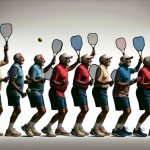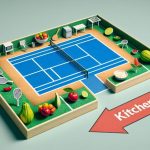Imagine this: you’re at a lively bar, relishing in the company of your friends and indulging in your favorite drink.
Suddenly, your gaze lands on someone across the room who immediately catches your attention. They exude confidence and charm, and they are clearly having a great time.
Your heart starts racing as you contemplate making a move, but then it hits you—the infamous “two bounce rule.” Is it just a myth, or is there some truth to it?
As single individuals navigating the tumultuous waters of dating, we’ve all heard about this supposed rule. But does it hold any weight in today’s modern dating landscape?
Let’s delve into the debate and uncover whether the two-bounce rule truly applies to singles.
Table of Contents
Want to play pickleball? Let’s learn the rules.
It’s no surprise that this combination of tennis, badminton, and table tennis has been gaining popularity in recent years. But before you hit the court, it’s crucial to have a thorough understanding of the game’s rules. And one rule that often leaves players perplexed is the two-bounce rule.
So what exactly is the purpose of this rule in pickleball? Simply put, it requires both teams to let the ball bounce once before returning it after a serve. This rule applies specifically to doubles matches and serves as a barrier against players who try to volley the ball out of the air. By enforcing this two-bounce rule, longer rallies are created, and strategic play becomes more essential.
But what about singles matches? Interestingly enough, the official rules of pickleball or even tennis do not explicitly mention the two-bouncing rule. However, some players and leagues have chosen to adopt it in singles matches. The reasoning behind this decision is to level the playing field between seasoned and inexperienced players. In doubles matches, having a partner can make up for a player’s lack of skill or speed.
However, in singles matches, a player must rely solely on their own abilities. By implementing the two-bouncing rule, players are given more time to make shots, potentially evening out the competition.
There are valid arguments against incorporating this rule into singles matches. Some believe that it goes against the fast-paced nature of these sports and takes away from the excitement of hitting powerful shots.
There are also concerns about inconsistency in its application, as it is not an official rule and can lead to disputes and disagreements during a match.
Ultimately, whether or not the two-bouncing rule applies to singles matches depends on the preferences of the players and the guidelines set by the league or tournament.
As an expert on pickleball, my advice would be to clarify with your opponent or the league before the match begins whether or not the two-bouncing rule will be in effect. This will prevent any confusion or disagreements during the game, ensuring a fair and enjoyable experience for all players.
Pickleball court and equipment
With its unique blend of tennis, badminton, and ping pong, pickleball has become a popular sport in recent times.
But before you embark on your pickleball journey, it is crucial to familiarize yourself with the dimensions of the court and the equipment necessary for a great game.
Equipment:
At the heart of pickleball lies the paddle, an essential piece of equipment that comes in various shapes and sizes. The standard size for a paddle is 8 inches wide and 15 inches long, with a handle measuring around 5 inches. However, players can choose from different grip sizes to ensure comfort and control while playing. Paddles are typically made of lightweight materials like graphite or composite materials, allowing for better maneuverability on the court.
Next up is the pickleball itself—a unique ball made of durable plastic with holes, giving it a distinctive flight pattern. The standard size of the ball is slightly larger than a tennis ball, with a diameter of 3 inches and weighing approximately 0.9 ounces.
Apart from these essential items, players can also opt for additional equipment such as protective eyewear, court shoes, and wristbands. Protective eyewear is highly recommended to prevent injuries from stray balls or collisions with other players. Court shoes provide proper grip and support while moving around the court, while wristbands help absorb sweat and keep hands dry during gameplay.
Court Dimensions:
Now that you have your equipment ready, let’s delve into the dimensions of a pickleball court. For doubles play, a standard pickleball court measures 20 feet wide and 44 feet long, while for singles play, it measures 20 feet wide and 22 feet long.
The court is divided into two equal halves by a 34-inch-high net placed in the center. The net extends 22 feet from each side of the court, with sidelines marked at 22 feet and baselines at 20 feet from the net.
The pickleball serve
Pickleball is a thrilling and fast-paced sport that has gained immense popularity in recent years. Like any racket sport, there are specific rules and regulations that players must adhere to for a fair and enjoyable game. One of these rules, the two bounce rule, is a crucial aspect of pickleball that every player must understand.
But why is the two-bounce rule so important? And when does it come into play? Let’s delve into this topic and explore the significance of this rule in the world of pickleball.
The Purpose of the Two-Bounce Rule
The two-bouncing rule was implemented to level the playing field and prevent the serving team from gaining an unfair advantage over the receiving team. In pickleball, serves can be powerful and swift, making it challenging for the receiver to react quickly. By requiring both teams to let the ball bounce once before returning it, the game becomes more balanced. This rule gives the receiving team a fair chance to return the serve and maintains an intense level of competition.
When does it apply?
The two bounce rule only applies during the first two shots of each point. This means that after the serve, both teams must allow the ball to bounce before returning it. However, once the ball has bounced twice, either team can hit it without any restrictions.
It’s important to note that this rule only applies to serves. Once the point has started, players can volley (hit the ball before it bounces) without any limitations.
Double-bounce rule
The Enigmatic Strategy of the Double-Bounce Rule in Racket Sports: A Game-Changer for Fairness and Intensity
The enigmatic double-bounce rule is a crucial yet often misunderstood aspect of racket sports that has sparked countless debates among players. It is a rule that applies to both singles and doubles matches and plays a monumental role in promoting strategic gameplay and fairness on the court.
In this riveting blog post, we will delve into the purpose of the double-bounce rule and its profound impact on gameplay. We will also explore how this rule is applied in different racket sports and any intriguing variations that may exist.
The Purpose of the Double-Bounce Rule
At its core, the double-bounce rule was introduced to elevate the intensity and depth of rallies in racket sports. By mandating players to let the ball bounce twice before returning it, it creates more opportunities for a prolonged back-and-forth exchange between opponents, making the game an enthralling spectacle for players and spectators alike.
Furthermore, the double-bounce rule adds an element of equity to the game. It prevents players from capitalizing on weak shots or exploiting their opponent’s positioning on the court. This levels the playing field for all players and places greater emphasis on skill and strategy than sheer power.
Impact on Gameplay
The double-bounce rule has a profound impact on gameplay in racket sports, especially in singles matches. In these matches, where one player covers the entire court, the rule can be particularly demanding. It requires players to anticipate their opponent’s shots and swiftly maneuver into position for a successful return.
This not only adds a physical component to the game but also requires mental acuity and quick decision-making skills. Players must think strategically about shot placement and court positioning to outsmart their opponent.
Application to Different Racket Sports
The double-bounce rule applies to various racket sports, including pickleball, tennis, badminton, and table tennis. However, there may be slight variations in how the rule is implemented in each sport.
In pickleball, for instance, the double-bounce rule is crucial to maintaining a fair and intense game. As mentioned earlier, it acts as a balancing beam, giving both teams an equal opportunity to return the serve and keep the game fiercely competitive.
In tennis, the double-bounce rule is not as strictly enforced as in pickleball.
Pickleball faults
As a seasoned racket sports player, I have learned the importance of preventing pickleball faults through practice and understanding the rules. With my expertise, I have gathered some effective tips that will help you improve your game and avoid costly errors.
Consistent practice leads to perfection.
The key to avoiding pickleball faults is to practice regularly with your partners. By doing so, you can develop muscle memory and become well-versed in the rules of the game. This will enable you to anticipate your opponent’s moves and make strategic decisions, ultimately reducing the likelihood of committing a fault.
Knowledge is power.
Having a thorough understanding of pickleball rules is crucial to preventing faults. Familiarize yourself with the double-bounce rule, which requires players to let the ball bounce once on each side before hitting it back. While this rule adds intensity and fairness to the game, it can also be challenging to master. However, by knowing and following the rules, you can avoid potential faults and elevate your gameplay.
Be cautious in the kitchen zone.
The kitchen zone, or no-volley zone, is where most pickleball faults occur. This area, located close to the net, is considered contentious as it is associated with numerous potential faults. To steer clear of any infractions in this zone, ensure that your feet do not touch the line while volleying. Maintaining control over your footwork and staying behind the kitchen line at all times is crucial.
Watch Your Footwork
Foot faults occur when a player steps on or over the baseline while serving or receiving a shot. To prevent this type of fault, pay attention to your foot placement during serves and returns. Additionally, practicing proper footwork techniques can significantly reduce the risk of committing a foot fault.
Stay within bounds.
Lastly, always keep an eye on the sidelines and baseline while playing pickleball. It is critical to stay within the boundaries to avoid faults. Make sure to toe the line and be mindful of your foot placement, ensuring you do not step on or over the lines during gameplay.
In conclusion, achieving fault-free pickleball gameplay requires practice, knowledge of the rules, and proper footwork. By following these tips, you can elevate your game and minimize the chances of committing a fault.
Winning a pickleball game
Pickleball is a dynamic and thrilling racket sport that has been gaining immense popularity in recent times. Combining elements from tennis, badminton, and ping pong, it requires both skill and strategy to emerge victorious. As an expert in the art of winning pickleball games, I have discovered that understanding and utilizing the double bounce rule is a key component to success.
What is the Double Bounce Rule?
The double bounce rule in pickleball dictates that the ball must bounce once on each side of the net before it can be volleyed. This means players cannot hit the ball mid-air on their first shot, adding an extra layer of strategy and finesse to the game. Bill Bell, a world champion, first introduced this rule in 1965, and it has since become an essential component of pickleball.
How can it lead to winning a game?
Offers a Framework for Shots
The double bounce rule serves as a framework for deciding which balls to bounce during rallies. This aids players in making more strategic shots and avoiding costly mistakes. By adhering to this rule, players can also engage in longer rallies and increase their chances of winning the point.
Prevents immediate aggressive play
Without the double bounce rule, players could immediately volley the ball from the serve, resulting in aggressive and potentially unfair gameplay. However, with this rule in place, players have an equal opportunity to return the ball, creating a more balanced playing field.
Allows for Redemption from Mistakes
In pickleball, mistakes are bound to happen. But with the double bounce rule, players have a chance to recover by letting the ball bounce before returning it. This helps prevent frustration and enables players to stay focused on the game.
Increased Scoring Possibilities
By requiring two bounces before volleying, the double bounce rule opens up more scoring opportunities for players. This adds an extra element of excitement to the game and allows for more strategic play.
Applicable to All Game Types
Whether it’s singles, doubles, or mixed doubles, the double bounce rule applies to all game types. This makes it a valuable rule for all pickleball players to understand and utilize.
Play pickleball at CA.
As a dedicated pickleball player at CA, you may be familiar with the two-bounce rule in singles pickleball. But do you truly understand its nuances and how it affects the game? In this blog post, we will delve into the intricacies of the two-bounce rule and its impact on gameplay at CA.
So, what exactly is the two-bounce rule? In simple terms, it dictates that players in singles pickleball must let the ball bounce twice before returning it after a serve. This means that both the server and receiver must allow the ball to bounce once on their side before striking it back at their opponent. The ball must then bounce again before the server can make a return shot, initiating a rally.
While this rule may seem like a small technicality, it has a profound influence on gameplay. Let’s explore some key ways in which the two-bounce rule shapes the dynamics of singles pickleball at CA:
- Strategic Redemption: By granting players more time to recover from mistakes or poorly executed shots, the two-bounce rule allows for strategic redemption. This gives players the chance to redeem themselves and continue the rally instead of immediately conceding a point.
- Slower Pace: Compared to other racket sports such as tennis or badminton, pickleball has a slower pace due to the two-bounce rule. This affords players more time to strategize and plan their shots, resulting in a more tactical game.
- Longer Rallies: The two-bounce rule also contributes to longer rallies as players have additional time to react and return shots. This can create an exhilarating and intense game as players fiercely compete for every point.
- More Scoring Possibilities: With two bounces required before returning the ball, there are more chances for creative shots and scoring opportunities. This adds an element of excitement and unpredictability to the game, keeping players on their toes.
In conclusion, the two-bounce rule in singles pickleball has a considerable impact on gameplay at CA. It allows for strategic redemption, slows down the pace, leads to longer rallies, and opens up more scoring possibilities. So next time you’re playing pickleball at CA, keep the two-bounce rule in mind and utilize it to your advantage.
Conclusion
In the world of singles pickleball, there’s one rule that stands out above all others: the two-bounce rule. As a player at CA, you may have come across this rule and wondered about its significance. But after reading this blog post, you now know that it goes beyond just being a technicality; it shapes the very essence of the game.
The two-bounce rule adds an extra layer of strategy and fairness to singles pickleball at CA. It allows for strategic redemption, a slower pace, longer rallies, and more scoring possibilities. With more time to react and plan their shots, players are able to showcase their skills and create an exhilarating and intense atmosphere on the court.
But the impact of this rule extends beyond gameplay. It serves as a unifying factor for players of all levels at CA, from beginners to seasoned pros. By leveling the playing field between skill levels, it promotes inclusivity and fair competition.






